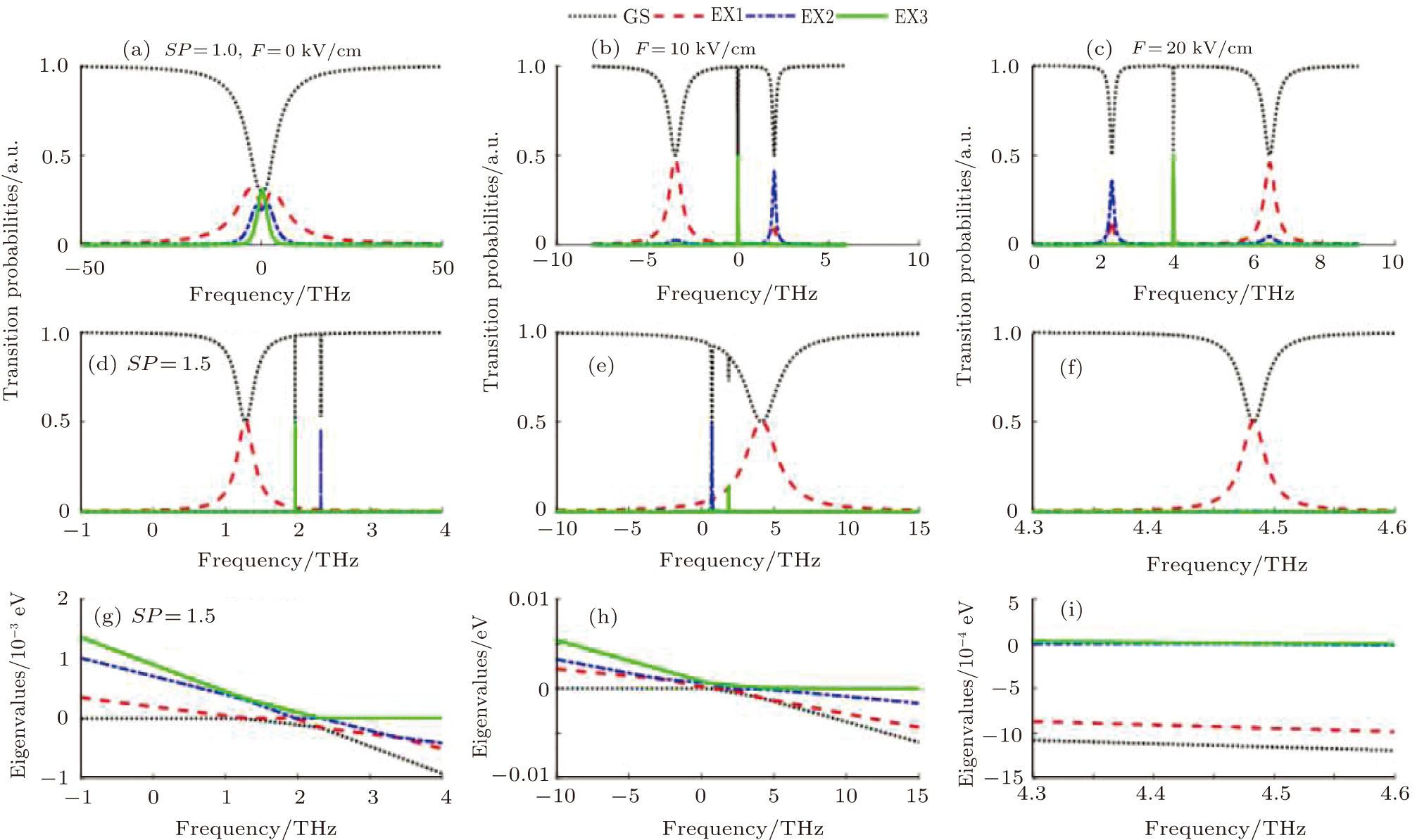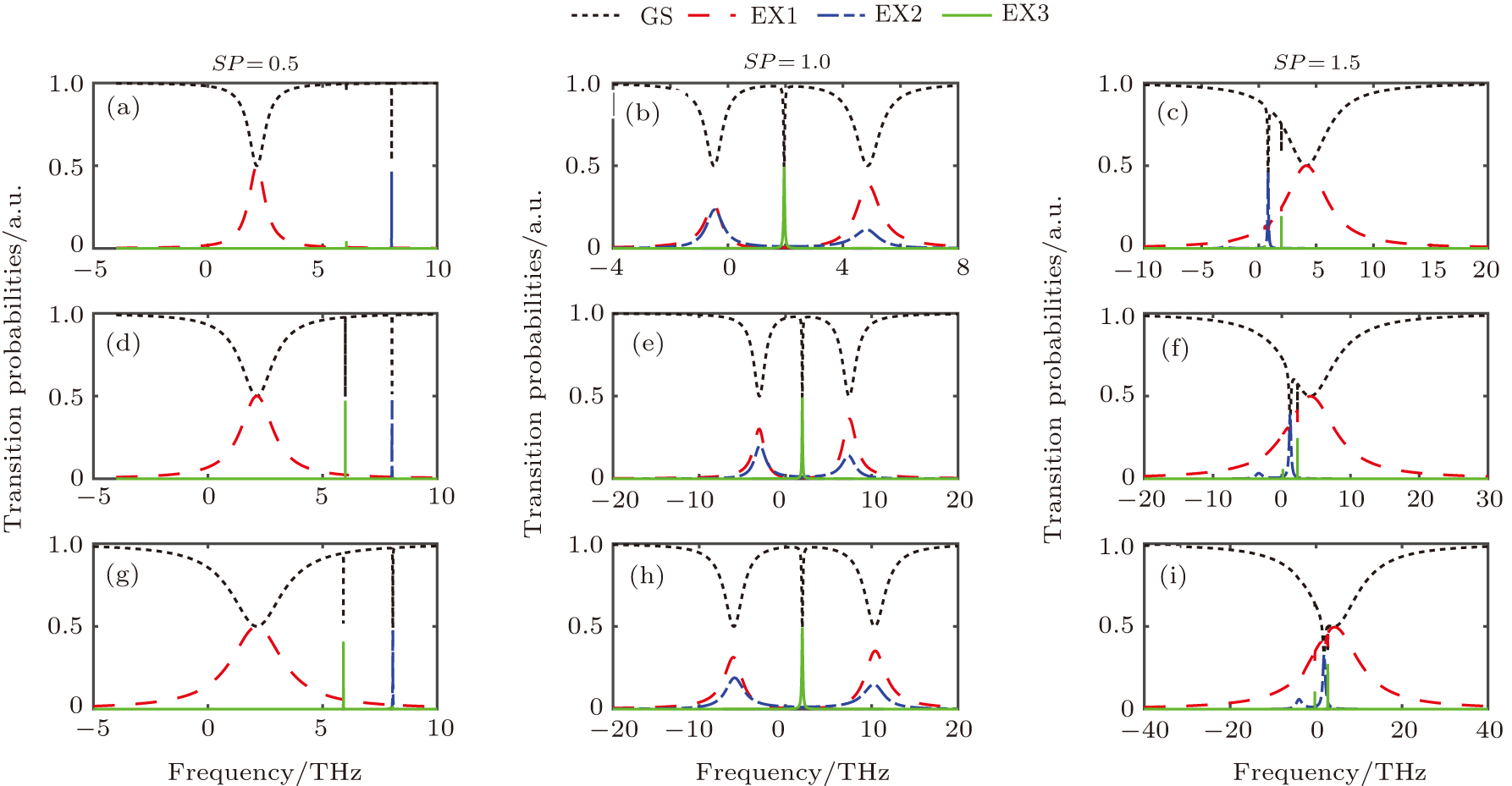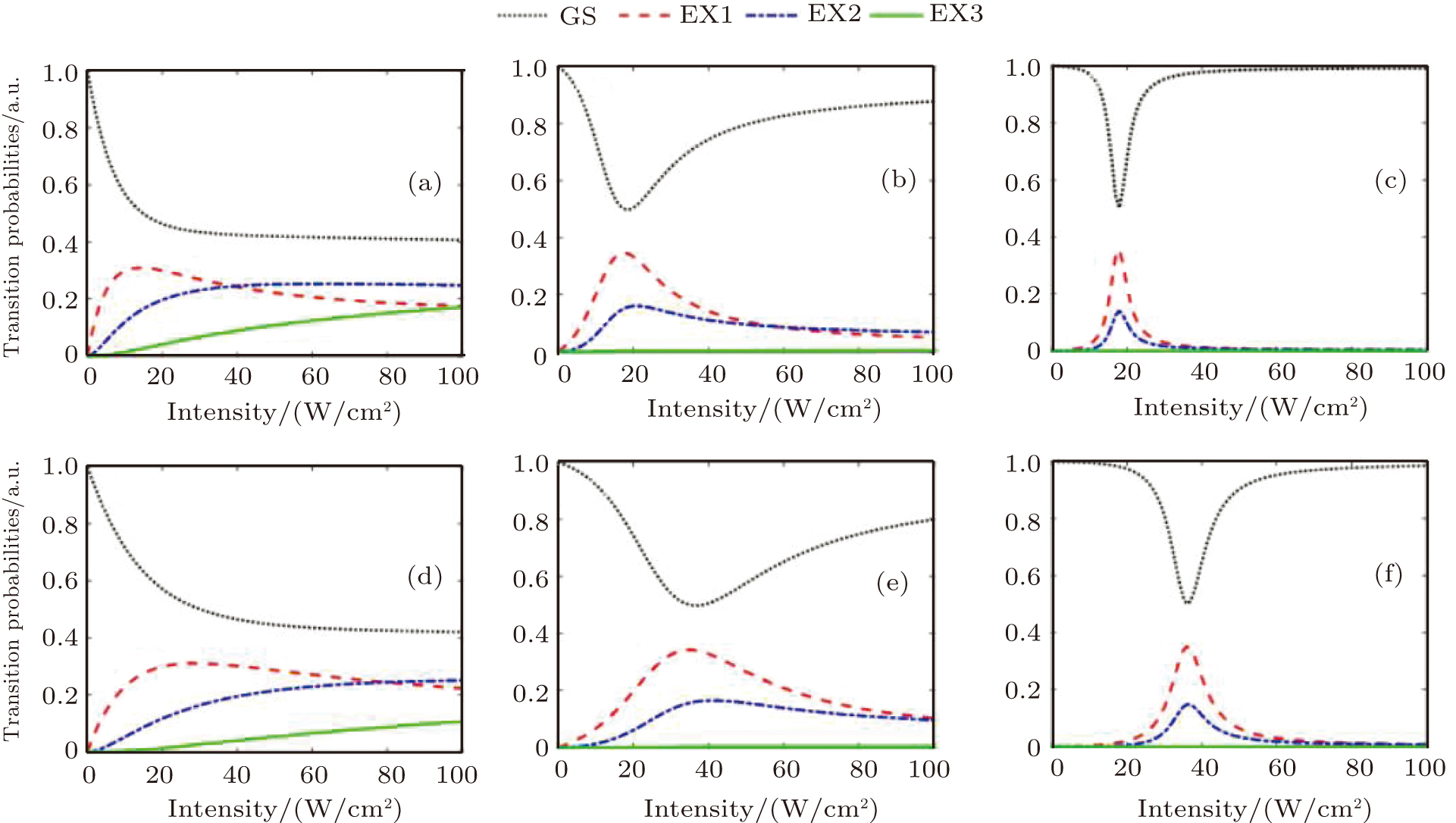† Corresponding author. E-mail:
Multiphoton excitations and nonlinear optical properties of exciton states in GaAs/AlxGa1−xAs coupled quantum well structure have been theoretically investigated under the influence of a time-varying high-intensity terahertz (THz) laser field. Non-perturbative Floquet theory is employed to solve the time-dependent equation of motion for the laser-driven excitonic quantum well system. The response to the field parameters, such as intensity and frequency of the laser electric field on the state populations, can be used in various optical semiconductor device applications, such as photodetectors, sensors, all-optical switches, and terahertz emitters.
The terahertz (THz) regime of the electromagnetic spectrum is commonly recognized by the frequency range of 0.1 THz–30 THz.[1] In the last few decades, progressive growth of various experimental techniques to control the dimensions and complexity of nanostructures as well as the development of various THz sources such as free electron lasers,[2,3] quantum cascade lasers,[4] and the accelerator-based THz light sources that can emit radiation with peak power in the megawatt region[5] has led to the expansion of interest of researchers to study the optical properties of quantum nanostructures. Immense literature work has been devoted to the optical studies of quantum nanostructures using THz sources that have profound utilization in the fields of pharmaceutical and biomedical,[6] industrial, environmental and meteorological applications,[7] security systems,[8] detecting explosive agents,[9] etc. Notably, semiconductor quantum wells have been probed for the terahertz detection using intersubband transitions in GaAs/AlGaAs quantum wells, which has led to the evolvement of new devices operating in the infrared and far infrared regions such as far-infrared photo-detectors,[10] all-optical switches,[11] high-speed electro-optical modulators,[12] and infrared lasers.[13]
The structure parameters of the quantum structures, especially the shape of the quantum well and potential specifics, are important criteria to study the optoelectronic properties covering a wide spectral range.[14–19] In quantum wells structures, light irradiation creates the electrons and holes in the quantum well, which are often bound to form neutral excitons. The suitability of THz laser devices to study excitonic interactions can be asserted on the fact that intraexcitonic energy spacing between exciton states is comparable to the wavelength range in which the THz laser devices operate. At present, there are various experimental techniques that may be used to investigate the excitonic optical properties, such as photoluminescence (PL) spectroscopy, near-infrared (NIR) absorption spectroscopy, etc., using THz light sources. The analysis has many practical applications. For instance, Wagner et al. observed the near-infrared transmission of a semiconductor multiple quantum well probed under intense terahertz illumination and provided a scheme for an ultrafast, normal-incidence optical modulator.[20] Galbraith et al. experimentally studied PL and terahertz absorption spectra of a GaAs multiple quantum well, indicating the experimental detection of a population of bound exciton.[21] Rice et al. experimentally studied exciton transitions mediated by Coulomb interactions in photoexcited semiconductor quantum wells. The experimental evidence of the PL emission acted as a good fingerprint to identify excitonic populations.[22] Su et al. demonstrated the use of THz driven gated double quantum well for voltage-controllable wavelength converter.[23]
In this paper, we introduce a four-level excitonic quantum well (EQW) system made by two GaAs/AlxGa1−xAs quantum wells, and study the multiphoton transitions using a periodic laser field and static electric field. Perturbative methods have been used to study the interaction of high-intensity lasers with EQW under the influence of dc electric field as well.[24,25] The perturbation theory has the disadvantage that it declines when the radiation intensity is too large or when the radiation frequency is close to one of the eigenfrequencies. Further, the perturbative methods are applicable when the energy difference between initial and final transition states is very large as compared to the corresponding transition matrix element. An exact, nonperturbative method, based on Floquet analysis primitively introduced by Shirley,[26] has been pursued for the problem. Using this approach, the Floquet states are obtained in the Fourier domain. We provide the study of the variation of Floquet states and quasienergies as a function of the laser field parameters (strength and frequency) as well as dc electric field. The method has been successfully applied in the molecular as well as in quantum heterostructures[27–29] to study the evolution of states. The quantum wells are the budding candidates for these studies as they have the advantage in adjustable design, prolong dephasing times, considerable dephasing rates (∼10 ps), tractable interference strength, and large electric dipole moment as compared to other quantum well structures.
Although the primitive interest for such studies is theoretical and various physical applications of the problem have been theoretically explored earlier in quantum heterostructures such as controlling electron transport in few-electron quantum dots to fabricate a quantum switch,[30] production of currents in an ac-driven quantum dot,[31] absorption and the nonlinear sideband generation,[32] and low-frequency dynamics,[33] these results may be experimentally observable. Floquet bands and quasi-energies were interpreted by the spectroscopic techniques such as pump-probe experiments and time and angle-resolved photoemission spectroscopy (Tr-ARPES) in graphene[34] and in monolayer transition metal dichalcogenides (TMD).[35] To the extent of our knowledge, no such experimental studies are available in excitonic quantum nanostructures. We hope that our theoretical results will stimulate experimental researchers to carry out such experiments in excitonic quantum nanostructures.
This paper is organized as follows: the theoretical framework is described in Section
In this section, we provide the theoretical minimum for the understanding of physics involved with an interaction of our excitonic quantum mechanical system with the time-dependent periodic perturbation in the form of a laser field. The notation used is consistent throughout with conventional symbols and atomic units (







 |


We assume the total EQW wavefunction is of the form 
 |


 |

 |
The index k (

 |


 |
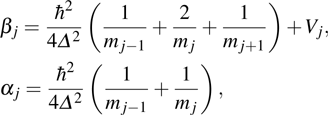 |

 |





Next, we study the interaction of our EQW system with a periodic field in the form of a monochromatic laser using Floquet quasienergy formalism. We discuss how the quasi-energy-state eigenvalues and eigenvectors may be determined through the solution of a stationary matrix eigenproblem, a method first introduced by Shirley[30] for a two-level quantum system in a periodic field. The theory has proved to be quite useful in studying the evolution of bound states with the periodic laser field. We consider the interaction of our EQW with a monochromatic linearly polarized periodic laser field along the z-axis and transition dipole moments are taken to be aligned with the polarisation direction. The Schrödinger equation for the interaction can be written as
 |
 |


 |

According to the Floquet theorem, the wave function 
 |



 |
Therefore, a quasienergy state can be considered as a superposition of stationary states with energies equal to 


 |
Substituting Eqs. (
 |
 |
The above set of coupled equations can be recalibrated into an eigenvalue matrix equation
 |











The probability of the occurrence of a transition between two quantum states, which is important for understanding many aspects of laser behavior, is given by
 |



 |
 |
The method has advantages which include the removal of rapidly varying optical frequency from the time-dependent interaction Hamiltonian by transforming it into a time-independent Floquet Hamiltonian which can be easily diagonalized using standard coding in various scientific software including Fortran and Matlab, which are quite simple and accurate. We obtain the eigenvectors which are the dressed states or the adiabatic Floquet states of our quantum system and the eigenvalues are the quasienergies. Various nonlinear effects such as power broadening, dynamical Stark effect, etc., can be interpreted using the avoided crossing patterns in the quasi-energy diagram. The slow variation of amplitude and strength of laser field, multiphoton transitions between various levels, the shift of various states, etc., can be incorporated easily using this dressed picture representation which cannot be visualized using even the lowest-order perturbation theory.
The material parameters considered in this study are in accordance with the reference.[36] The coupled quantum well under consideration consists of two GaAs wells with the right well width (RWW) of 8 nm. The AlGaAs barrier width (BW) is taken to be 2 nm. The aluminium concentration (x) is kept constant at 0.33. We define the skewness parameter (SP) as the ratio of right well width to left well width (LWW). The background dielectric constant is 













 |
The single-particle states and the corresponding wavefunctions are shown for the two cases of the static electric field: F = 0 and F = 10 kV/cm in Fig. 








 | Fig. 1. The wavefunctions and the well potential for F = 0 kV/cm and F = 10 kV/cm for SP = 1.0 and BW = 40nm. |
To study the evolution of EQW states with a periodic laser, the Floquet theory is implemented to obtain the Floquet time-independent Hamiltonian in the form of the infinite matrix HF, as discussed in Section
 |
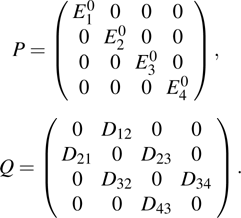 |
The Floquet Hamiltonian is an infinite tridiagonal matrix with a periodic structure featuring only terms in the diagonal elements in various photon blocks. The structure endows the dressed quasienergy eigenvalues and eigenvectors of HF with periodic properties. The Floquet matrix includes the interaction of the quantum system with the periodic laser field in the off-diagonal terms of matrix type Q featuring elements
 |

We considered the interaction of a single-mode sinusoidal periodic laser field with the exciton states of coupled GaAs/AlxGa1−xAs coupled double quantum well with a rectangular confinement potential. We apply the electric dipole approximation for the carrier–radiation interaction. The corresponding electron wave functions and quasienergies are obtained by the Floquet formalism. The analysis of our numerical results is as follows.
In Fig.
In Figs.
Modern spectroscopy relies largely on high power lasers. The commencement of non-perturbative effects with radiation intensity can be seen in Fig. 
In Fig.
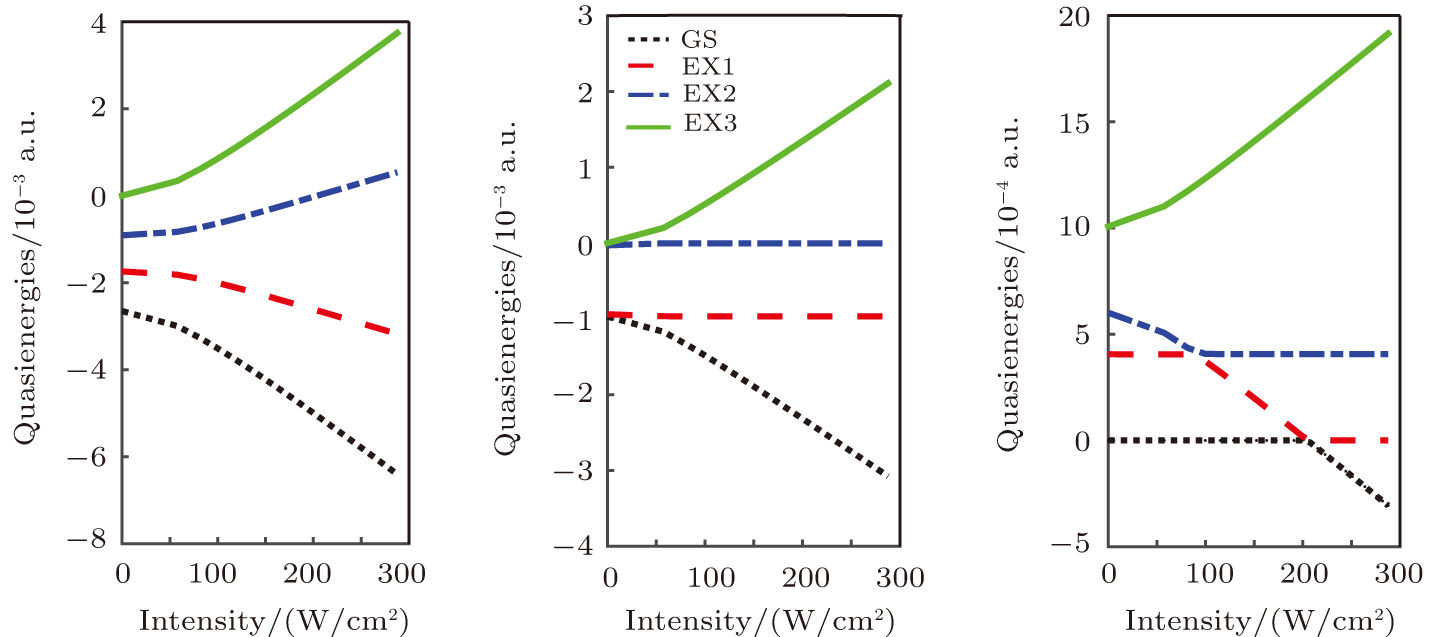 | Fig. 4. Dressed states quasienergies as a function of the laser field intensity for different static field strengths: F = 0, 20, and 55 kV/cm. |
In Fig.
In conclusion, in the preceding study, we have investigated the interaction of EQW with a strong, periodic THz laser field, and static electric field. The numerical technique employed to obtain the unperturbed states of EQW system is employed in this work, which is the well-constructed central second-order finite difference. The interaction with the laser field is described with a nonperturbative Floquet approach, providing a time-dependent solution of the Schrödinger equation. We obtain analytical expressions for the variation of the quasienergies and Floquet states as functions of the field parameters. Many nonlinear effects are observed including the avoided crossing of dressed states, power broadening, and ac-Stark shift. The study can provide a strong impetus for the development of novel optoelectronic devices such as electro–optical modulators, photodetectors, sensors, and quantum switches.
| [1] | |
| [2] | |
| [3] | |
| [4] | |
| [5] | |
| [6] | |
| [7] | |
| [8] | |
| [9] | |
| [10] | |
| [11] | |
| [12] | |
| [13] | |
| [14] | |
| [15] | |
| [16] | |
| [17] | |
| [18] | |
| [19] | |
| [20] | |
| [21] | |
| [22] | |
| [23] | |
| [24] | |
| [25] | |
| [26] | |
| [27] | |
| [28] | |
| [29] | |
| [30] | |
| [31] | |
| [32] | |
| [33] | |
| [34] | |
| [35] | |
| [36] | |
| [37] | |
| [38] | |
| [39] | |
| [40] | |
| [41] |


